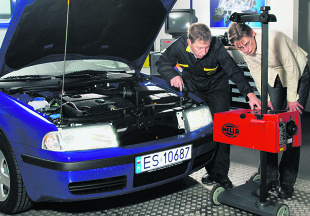
Department: Science, Research - Set an example
 Patronage: ITS. The condition of the car's lighting raises many concerns. There are several times more accidents per moving vehicle at night than during the day, and these accidents are much more serious. Most modern cars offer good lighting at an affordable price. However, you need to take care of them and adapt your driving technique to the possibilities of the lights.
Patronage: ITS. The condition of the car's lighting raises many concerns. There are several times more accidents per moving vehicle at night than during the day, and these accidents are much more serious. Most modern cars offer good lighting at an affordable price. However, you need to take care of them and adapt your driving technique to the possibilities of the lights.
 Posted in Science, Research
Posted in Science, Research
Board of Trustees: ITS
For safety, the condition of all three lighting elements is important: light bulbs, fixtures and light settings. When translating theory into practice, let's keep in mind that...
1. Lamps must be in good condition and clean
If the windshield of the car outside the area cleaned by the wipers is dirty, then so are the headlights. It is best to wash them with a clean cloth or sponge with plenty of water or a suitable liquid to avoid scratching the lampshades. If the lamps are dusty inside and can be unscrewed, they should also be cleaned. If cleaning is not possible, the lamps should be replaced.
2. All lights must be on.
They should be replaced in pairs. A complete set of spare lamps should always be in the car. Lamps must meet the vehicle manufacturer's specifications and be approved. The vehicle user should be able to change the bulbs using the vehicle's factory tool kit, and information on how to do this should be included in the vehicle's owner's manual.
Some bulbs on the market are of low quality. Xenons and cheaper LEDs dim over time, but do not burn out. It is almost impossible to check the quality of the bulbs on your own. The biggest problems are with very cheap light bulbs and various "inventions" with exotic descriptions on the packages and a lot of encouraging slogans. Installing them in headlights is a safety risk. Similarly, it is impractical to use LED "substitutes" for light bulbs. On the other hand, homologated lamps equipped with LEDs at the factory can be safely used.
3. Headlights must be correctly positioned
It is very important to adjust the light. This should be done in a workshop after every bulb change, after every mechanical repair that may affect the setup (suspension, body repair after an accident) and checked periodically.
4. Set the level according to the vehicle load.
Xenon does not belong to xenon. It is important to use the so-called. equalizer settings. It is worth checking in the car manual or asking the service how to set the corrector depending on how many people are sitting on the seats in the back or front and the amount of luggage. This issue does not affect factory equipped xenon vehicles that have an auto leveling device and vehicles with automatic suspension.
5. Night vision range may be limited
Even with properly adjusted headlights, low beam visibility is limited. Safe speed then can be only 30-40 km/h. It may be larger, but is not guaranteed. Therefore, at night with dipped beam, you can only overtake if you can see far enough.
6. A car is not a Christmas tree
It is not allowed to install and turn on during the movement of any additional lights visible from the outside of the vehicle, except for the standard equipment of the vehicle. Some lights strictly defined by law are exceptions. The set of car lights and their colors is strictly regulated by the regulations. Some headlamps may be optional but must be type approved (eg daytime running lamps, front fog lamps, additional reflectors). The operation of additional lights must be checked at the inspection station.
